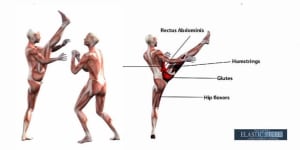
The lower extremity injuries that most martial artists come across are not necessarily unique to martial arts. They range from common tendinitis’, to a ‘pulled groin’ and ‘tweaked knees”. In this two-part blog summarizing common injuries to martial artists, I have addressed injuries to the lower extremities. I picked the common ones that I run across as an instructor and feel can be prevented with simple exercises. Try some of these exercises as part of your training. Give yourself 10 minutes to explore them and make them part of your routine.
KNEE – TENDINITIS : ANTERIOR
There are numerous ways in which the knee is placed under stress in the martial arts. I will address two different types of knee injuries. However, it is important to identify the common ways in which constant strain is placed on the knee (which may lead to chronic injuries). For the martial artist, kicking is a critical aspect of training. Upon analyzing the basic kicks, we can identify that there are the chamber-extension-chamber movements. It is the extension of the kick that often leads to tendinitis and other chronic pains. This can be caused by hypertension of the knee joint. Definitely experienced by beginners and when a partner is holding your pads or targets in the wrong place. Hypertension of the knee causes strain to the posterior capsule (back of the knee), the patellar tendons, as well as compression of the patella (or kneecap). It is this type of misuse of the knee that often presents as anterior (front – top or front bottom area) knee pain.
IDENTIFICATION OF PATELLAR FEMORAL DISCOMFORT OR TENDINITIS (ANTERIOR PAIN)
Weak quadriceps can lead to many different types of problems. When this type of weakness is coupled with hypertension of the knee it can lead to pain or discomfort around the anterior portion of the knee and thigh (front). The discomfort felt may range from a dull ache to a sharp pain around the knee cap. Because of the mechanics of a kick, the knee is vulnerable to stress from long-term hyperextending of the knee, via the chamber – extension – chamber steps of the kick. If the quadriceps are weak, then it is difficult to learn to control the extension of the kick without ‘locking it or popping it out.’ Furthermore, the condition can be accelerated if a martial artist practices throughout their career without shoes. The constant impact also causes the knee to weaken. In addition, chronic anterior tendinitis of the knee tends to be more common in women and will develop sooner, than in men, especially if the quadriceps and hamstrings are weak.
Tendinitis is a condition that is chronic and therefore is developed over time. Improper training, technical errors in a sport, unsupportive footwear and neglect to ice and rest when discomfort is felt can lead to many different chronic joint problems. Whether it is tendinitis of the knee, ankle or hip. It is critical to acknowledge when your knees appear to be swollen or ache (dull pain) after training.
TREATMENT
RICE is the most effective method of immediate care. As with most injuries, it is critical to seek the care of a physician. However, try exploring alternative methods of treatment, like dry needles, acupuncture, facia therapy and physical therapy.
IDENTIFICATION OF LATERAL KNEE DISCOMFORT: IT BAND (ILIOTIBIAL BAND ) STRAIN OR A LIGAMENT SPRAIN
When discomfort is felt on the side of the knee (lateral region) it could be either an IT band strain or a ligament sprain. With ligament sprains, the discomfort will range from instability of the inside of the knee which will easily be identified through pain when engaged in lateral movement (side to side: i.e. shuffling), to a sharp shooting pain along the side of the knee.
On the other hand, an IT band strain is a more difficult injury to identify. Usually, it is identified by ruling out most other knee injuries. However, when severe, the pain will surface itself in the hip. Since the IT band attaches in the hip, sharp pain may be present.
These types of injuries are common from sparring. For example, while sliding in on your opponent with a side kick and the weight of your body does not follow the movement of the kick. Even years of kicking without a thorough strength training regiment could lead to IT issues.
TREATMENT
As with all other conditions RICE must be followed. Any ligament or IT band damage will require a doctor’s referral for physical therapy. Strength training will be an integral part of recovery.
PREVENTION AND STRENGTH TRAINING
- Lunges or split squats are an important exercise to enhance quadriceps strength.
- Try using a suspension strap to assist with a single leg squat or modified pistol squat.
- Any banded balance movements are excellent for activation of the quad & strengthening of the lateral portion of the knee.
- Thorough un-contraindicated stretching should always accompany training. Lots of dynamic stretching. Combine this with stability movements. Most of these are single leg balances with a control dynamic action.
- Doing balancing exercises on a BOSU or balance board/pad works wonders in increasing overall knee joint strength. Anything from: standing one leg, squats, leg lifts, lunges and even slow kicks will create a stronger connection between every joint in the leg.
- Rolling out on a regular basis – all sections of the upper leg.
HAMSTRING STRAIN
The hamstring strain is located in the group of muscles on the back side of the thigh. The hamstring runs from behind the knee to the base of the buttock. Hamstring strains are small tears to the muscle. As with other strains or sprains there are three grades of severity. This common injury most often occurs from an improper warm-up. Many schools do not perform an active & dynamic warm-up before stretching or kicking. The an active dynamic warm-up phase is different than the sit and stretch. The active dynamic warm-up should involve any consecutive multi-joint movements for 6-10 minutes (squats, lunges, jacks, jump rope, low jumps, etc..) which elevates the heart rate and heats the muscles safely allowing laxity or stretching to occur. By adding dynamic movements to a warm up like jump rope, mini-hops, fast feet – you also accomplish turning on the central nervous system. Ideally dynamic stretching occurs before any deep static stretching. Once you have completed this, add- 3-4 minutes of light shadow boxing/kicking./martial movements and finish your dynamic warm-up by retreating to the ground for a series of activation exercises like: bridges, leg lifts, core work, etc.. Activation movements will lead to a more successful practice and can help to avoid injuries. Strains are often overlooked as normal onset muscle soreness from a tough workout, a proper active dynamic warm up can improve the quality of the overall workout.
IDENTIFICATION
Aside from severe tightening of the muscle which is often described as pain, a strain could also cause discoloration. The three grades are as follows:
GRADE I: Minimal microscopic trauma (tears) to the muscle (hamstrings), with minimal swelling, discoloration, a minimal loss of function, and discomfort commonly occurring from a poor warm-up and stretch phase . With a grade I strain, a burning sensation will often be felt during stretching, which is the most common symptom.
GRADE II: Discoloration or bruising is more prevalent at this level of severity. Macroscopic tears, possible discoloration, slight swelling, some loss of function and sharp pain is present.
GRADE III: The level of discoloration is higher and a divot can be felt on the back of the thigh along the muscle fibers. This divot will feel like a hole in the muscle. Severe pain and discomfort will follow along with loss of function.
TREATMENT
Rest, ice, compression and elevation is the best form of treatment. Also, seek the care of a physician so that the grade of sprain can be determined and the proper therapy can be prescribed.
PREVENTION AND STRENGTHENING
- Hamstring curls are the best form of strengthening. This can be done standing or lying on your stomach.
- A thorough warm-up preceding stretching, kicking, sparring, stance work or forms is the best preventive measure.
- Even split squats, lunges or walking lunges strengthens the entire leg to help ensure a stronger leg. This is an ideal exercise for preventing all of these injuries.
Are you interested in learning more about these recovery exercises?
Contact us today for more information on our personal training & martial arts programs!


